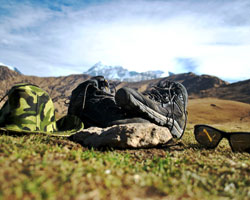When selecting a rucksack its construction & structure play a very important role. Primarily the construction and structure of a sack should take care of three things
1. Extreme Forces encountered during a Trek
2. Weather Encountered en-route
3. Impact on body
Lets discuss these one by one in detail
1. EXTREME FORCES
A sack can bear the extreme forces encountered only when it’s well constructed, material selection is right, all the zippers and buckles are selected diligently .

Materials
Pack Cloth nylon – It used to be an ideal material for back packs before advent of new smarter material but still it’s perfect for backpacks. Great acceptance to water proofing, abrasion resistant and excellent puncture resistant, what else do you need. Only downside is that it doesn’t provide firmness to structure if thinner grade is used, so go for thicker grade which will add another 500gms to your sack.
Cordura nylon - It's the most popular fabric used today for both backpacks. The advantages of Cordura fabric are its abrasion resistance and light weight. It's not as puncture resistant as pack cloth nylon and doesn't accept waterproofing as well (only marginal difference here), but it's also a perfectly good backpack fabric.
Rip Stop nylon - The main advantages of rip-stop nylon are it's ready acceptance of waterproofing and it's lightness in weight. It's not as puncture resistant as pack cloth nylon, but just about as abrasion resistant.

Did you know that the entire sack is not made of same grade of fabric even if the type of fabric is same , to make sacks lighter.
Main Body – Fabric used for main body have widely spaced fabric pattern because of two reasons.
. It has less amount of material per square inch which makes it lighter.
. Wider spacing is good for water proofing and stitching, too narrow spacing makes the fabric weaker during stitching.
Bottom of sack and shoulder straps – Here the fabric pattern consist of very narrowly spaced fabric strand because you need excessive abrasion resistance in these two spots.Waterproofing isn’t that much of a problem in here.

Stitches- Most backpacks have 8-10 stitches per inch, below 6 is a complete no-no. You can easily measure it by placing a scale and counting the stitches. Going beyond 10 decreases the fabric strength.
Buckles/Connectors – You don’t want your sack to open on its own while on trail and your stuff sown around in the mountains. Buckles for the straps are very important aspect you can’t ignore. Most of the good buckles are available in Acetal and Nylon.
Zippers – Always go for plastic coiled zippers, plastic tooth zippers are also fine. Metal tooth zippers are a complete no.
Ergonomics – When on a trails its very painful to have to search for material in your own sack. So a sack must have separate chambers and pockets which can be accessed separately. Also it’s always good to have zipped pockets in the hip strap so that you can throw in those wrappers in them on the go instead of stuffing them in your pocket.
2. WEATHER
None of the sacks are water proof, but good ones are water resistant only. Branded ones have tags attached but what will you do with non branded ones. There are a couple of things you can do.
Blow air through the fabric – Well this is the most primitive of methods but still it can separate apples from oranges. But there are different coating these day which allows the air to pass but stops the water. Gore-Tex is one such example.
Check out the inside -Often waterproof fabrics will have a milky coating on the inside, or a rubbery interior, or a layer that looks like shrink-wrap on the inside. If the fabric is colored on the outside, but white and opaque on the inside, that’s a good sign it may be waterproof. If you can see a thin layer of shrink-wrap-like rubber on the inside of the fabric, it’s probably waterproof too.
Intensity of sunlight is much higher above 6000 ft than on the ground and those UV rays can definitely eat away the normal polymers we use in daily life. These days nylon is coated with silicon to protect the main fabric from debris contamination and UV rays.
3. BODY IMPACT OF A SACK
Now you know the basic construction and which material to select for your sack but there is one more thing that you need to consider, the impact of a sack on your body.
Your Body – And I am not kidding here, a wrong sack can sap your entire energy within first couple of hours, which you could have utilized in the entire day’s trek/hike. Result : you start looking for a potter or mule to off load your bag.
Most important thing is that your sack should be able to distribute the entire weight of the stuff you are carrying through-out your back and should not create pressure point.



Also Read
Part 1: Common Errors Of Rucksack Selection
Part -2 : Knowing Your Requirements Beforehand Can Help You Select A Better Rucksack


















